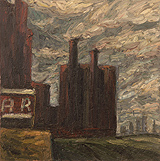Katya Arnold
dal 22/6/2005 al 16/7/2005
Segnalato da
22/6/2005
Katya Arnold
Matthew Bown Gallery, London
Jersey City Paintings: compelling essays in the neo-Expressionism that defined cutting-edge art in the early eighties. Yet in their acute sense of mutability and decay, in their intimate knowledge of the poetry of transience, they adumbrate a consciousness that increasingly shapes our shared culture: the deracinated and transplanted nostalgia of the emigre'.

Jersey City Paintings
In one sense, Katya Arnold's Jersey City paintings are very much of their era: compelling
essays in the neo-Expressionism that defined cutting-edge art in the early
eighties. Yet in their acute sense of mutability and decay, in their
intimate knowledge of the poetry of transience, they adumbrate a
consciousness that increasingly shapes our shared culture: the deracinated
and transplanted nostalgia of the émigré.
Russia, where Arnold began
painting at the age of 14, is not just a country with a very idiosyncratic
culture vacillating between East and West. Russia is a civilization on its
own gigantic scale.
This is why it is so hard for an artist to extricate
him- or herself from the Russian milieu: it requires not just a crossing of
the border but a breakaway from an entire mode of thinking. To feel free,
Arnold had also to break away from her highly placed and well established
family (her brother, Dmitri Arnold, is a Nobel Prize laureate in
mathematics); from her Soviet art school training; and, too, from the
intellectual tradition to which she felt she was linked with through her
mentor, the metaphysical painter Vladimir Weisberg, whose lifelong ambition
in art was to entrap light by breaking up the spectrum of white colour in
images of white objects set against a white background.
Katya Arnold
endured several types of exile. First, from a young age she was at odds
with the country of her birth, becoming what the Russians termed an ‘inner
émigré’: she moved in dissident circles, was frequently in trouble with the
authorities and eventually took part in the historic act of collective
rebellion known as the 'bulldozer' exhibition: a privately-organised
open-air show that the KGB smashed with bulldozers and which consequently
became a cause celebre for the world press (1974). Second, she got married
to an arch enemy of Weisberg's school of art - the creator of a parodist
pop-art version of Socialist Realism called sotsart, Alex Melamid. The
third exile came with emigration from Russia (1977) - first to Israel, then
to the United States. It was a difficult time for her and her family, a
time of hardship and the time of parting from the Russian past. No wonder
that when Arnold decided to bury this past in Jerusalem once and for all,
using the medium of a performance (1979), she resorted to a device known to
every Russian child: you create a sekretik - a little secret - by digging a
hole in the ground, hiding your precious mementos there inside and covering
the cavity with a glass so you can see the buried "past" like a colourful
treasure under a transparent glass screen. It was an ambiguous act: a
farewell to the beginning of her career, and to the familiar methods of
Moscow Conceptualism; but also (everything was meticulously sealed) a means
of preserving her oeuvre at a time of great uncertainty. In 1980 Arnold
moved to the United States.
Arnold's corner of the New World was Jersey
City, historically a manufacturing and transportation hub. The grey,
graphic palette of her brutal, grim, romantic and lyrical depictions of the
city was a direct violation of Wesiberg's metaphysical principles of pure
art, of "white on white". It was for her an attempt to discover a new
continent, a new beauty and, in essence, a new sense of self out of the
ostensible ugliness and garbage of slums - a romantic acceptance of new
reality regardless of its moral or aesthetic evaluation by outsiders. In
her own words, these paintings are about her ’love-hate relationship with
America and desire to find a “realâ€, not sterile or artificial, world.’
Jersey City, Arnold says, ‘happened to be dark, ugly and romantic at the
same time’. In the unrenovated urban landscape she became conscious of the
accumulated history of this conurbation of 250,000 inhabitants. She had no
roots here, yet now she was hankering after a vanishing New Jersey past
that symbolised in her mind a more innocent America. Perhaps a sense of
loss was being transferred, from one dilapidated cityscape to another. The
post-war urban working-class milieu that she memorialises in these canvases
was, in her phrase, ‘the era of jazz, drinking, smoking and simple
socializing’ : maybe not too remote from the bohemian Moscow of the
Brezhnev years that she had left behind (the critic Ekaterina Dyogot has
written of the ‘current of love, friendship and endless free time’ that
existed in the USSR in the years pre-perestroika).
Katya Arnold and Alex
Melamid have also become great connoisseurs of the rich culture of a
variety of ethnic restaurants in different ghettoes of Jersey City and its
environs. If you happen to move there, don't fail to contact them (they
both live in Manhattan now) - they will be the best guides to your new life
in the slums on the other side of Hudson River.
Private View: Thursday 23 June, 6.00-8.30 pm
Matthew Bown Gallery
First floor 11 Savile Row - London
June 20 - July 4: daily 12-18.00
July 7 - 16: Thursday-Friday, 12.00-18.00; Saturday 12.00-16.00



